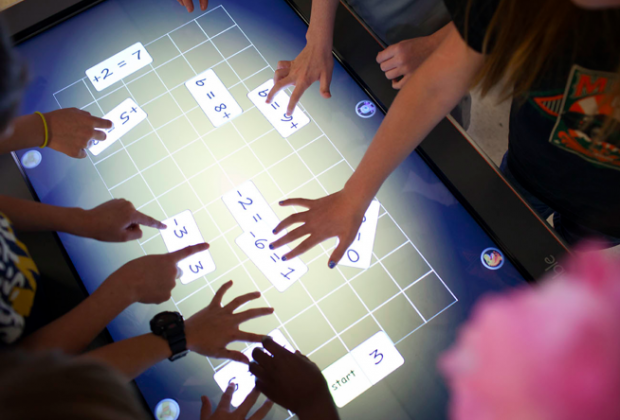All the activities that come with the table are aimed at four- to 11-year-old students and are designed to work best with small groups. The idea is that the table could be one of several “centers” set up in an elementary school classroom. This common teaching practice requires students to cycle around the room in small groups completing different activities at each “center.”
At a recent demonstration, the activity for the table requires students to measure angles. When that task is selected, a dozen brightly colored shapes pop up on the screen. Kids can make the shapes bigger or smaller and twist them around, but the proportions remain the same.
Each user stands at a certain spot around the table. Each spot comes with a workstation that has its own set of tools. The stations and their corresponding tools are each marked by an avatar—a cartoon character or an uploaded photo of the actual user. This provides the basis for tracking student input.
Once the shapes are on the table, kids can pull out a protractor tool and measure the degree of the angles on each shape. Like the shapes, the protractor shrinks and grows when kids pinch their fingers together or pull them apart over the object. That part is just like an iPhone or iPad, so the interface is pretty intuitive for students.
Once the angle is measured, kids can type out the measurement on a keypad and “stick” the number to the appropriate shape. When the activity is complete and the kids are ready to turn their assignment in to the teacher, they all have to press the “OK” button in front of their spot at the table. The idea is to make sure everyone is in agreement that the project is complete and is meant to promote community-minded thinking. (Though, it doesn’t take much imagination to picture the kid who refuses to ever press “OK.”)
The table then takes a screen shot and sends it to a file for the teacher to review later. When the teacher reviews the group assignment, which she can do right away or after the kids have left for the day, she can see things like how many angles each student measured, or if all the labeling was done by one child. She can even track things like how many times a student attempted to measure an angle on the red triangle before he got it right.
“If they use a plastic protractor, that data is lost in space,” said Marshall. “If they use a digital protractor, you can pull the data.”
That data is key to gaining a better understanding of what’s happening in the classroom and to pinpointing specific kids who need help on specific skills, Marshall said. Of course, for that data to be accurate, students have to use the table correctly. Manipulating the interface is only one part of it. If a student takes out her angle-labeling tool and then everyone shares it, it's going to look like she did all the labeling, and the other students won’t get any credit. For all that to be clear to kids, the teachers need training too, which the company offers.
As one might expect, the table isn't cheap -- at $8,000, it's roughly the price of 16 iPads. And outfitting a classroom with the entire suite of interactive tools can run up to an additional $4,000.
So is all that money and time spent to train teachers worth it?
That’s the question teachers and administrators are asking about this and other new technologies with high price tags. What does a tech device bring to a class that a creative teacher isn’t already providing?
It's not that tools like the ActivTable replaces creative teaching, Marshall said, it's that they enhance creative teaching by giving teachers the tools they need in the most modern framework possible.
Karon Taver, the executive director of education technology for Ft. Worth Independent School District, said teachers report feeling that the tool was made with them in mind and that it helps them better engage their students. “Do I think technology will replace great teaching practices and great teaching?” Taver asked. “Absolutely not. My feeling has always been: ‘This is a tool for great teachers to come up with great ideas.’”


